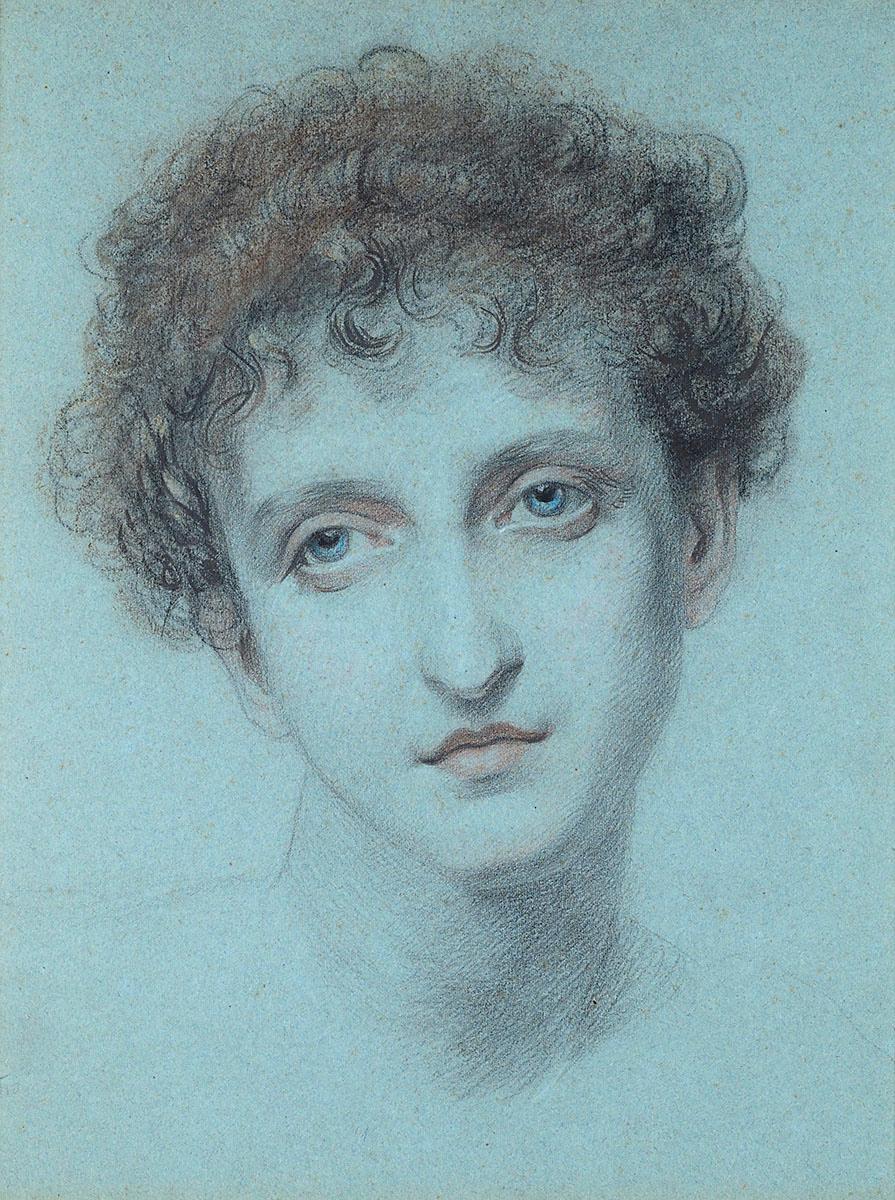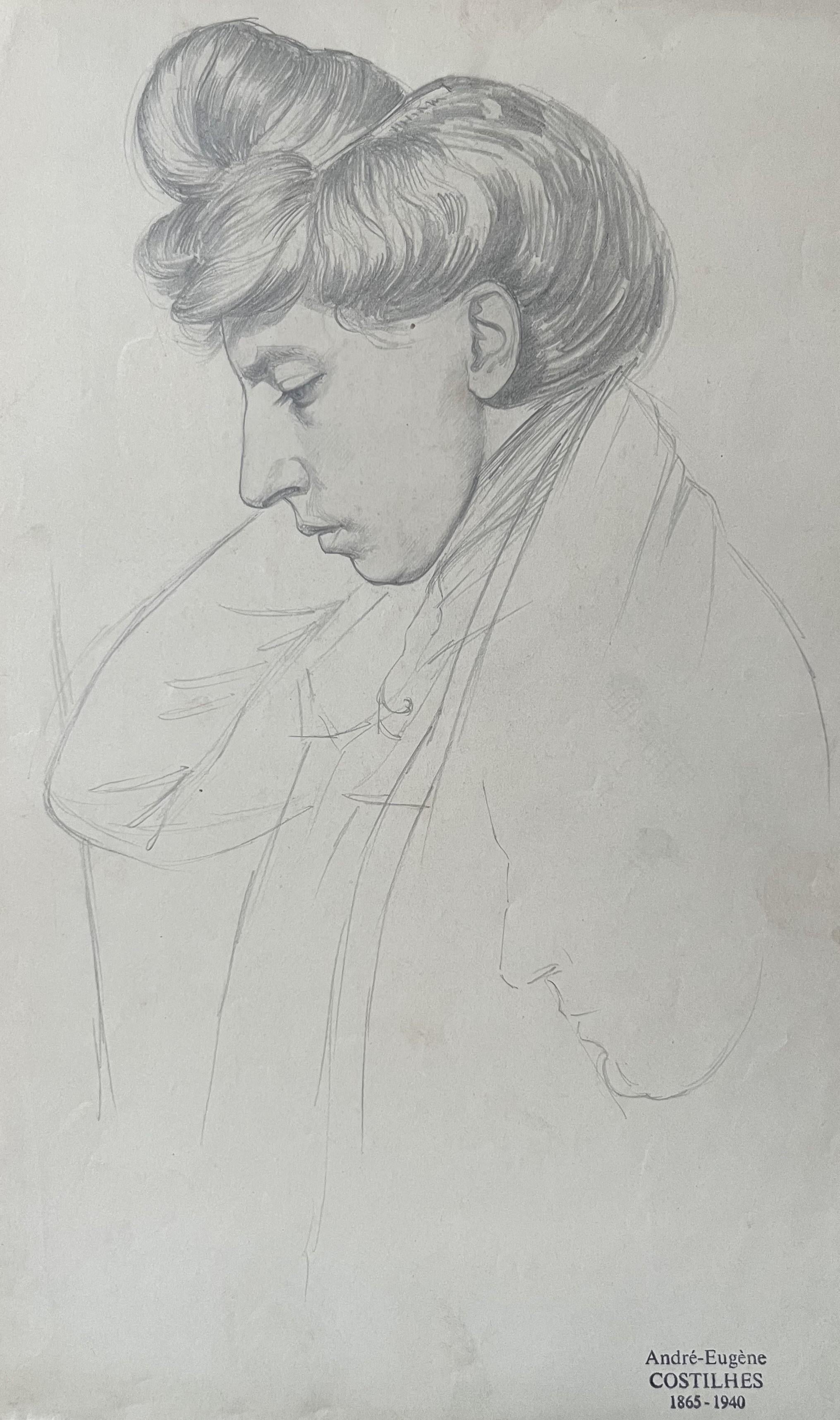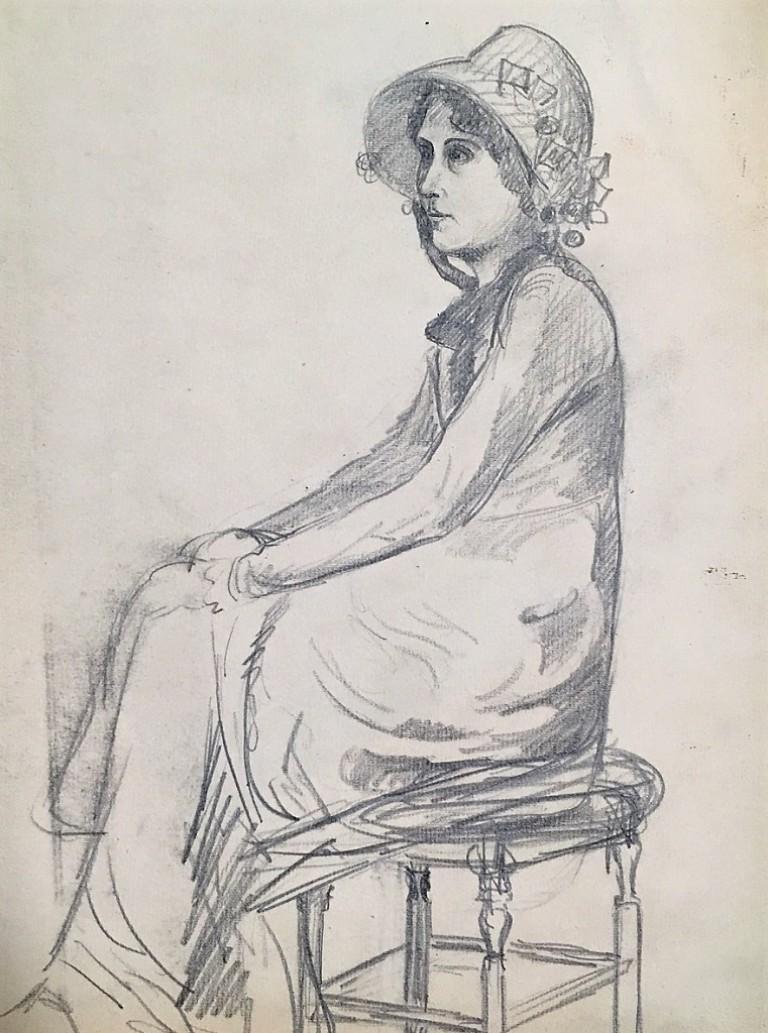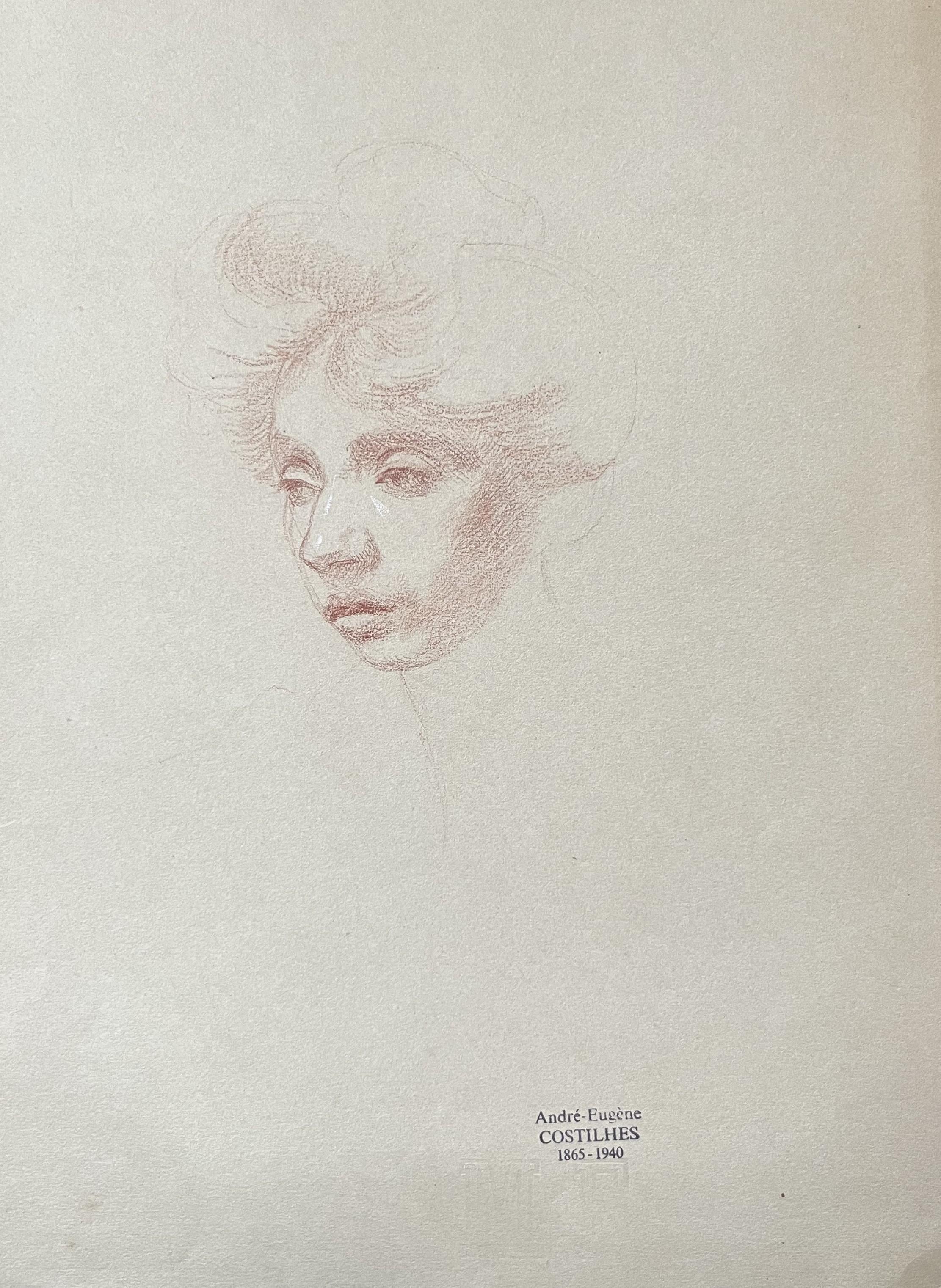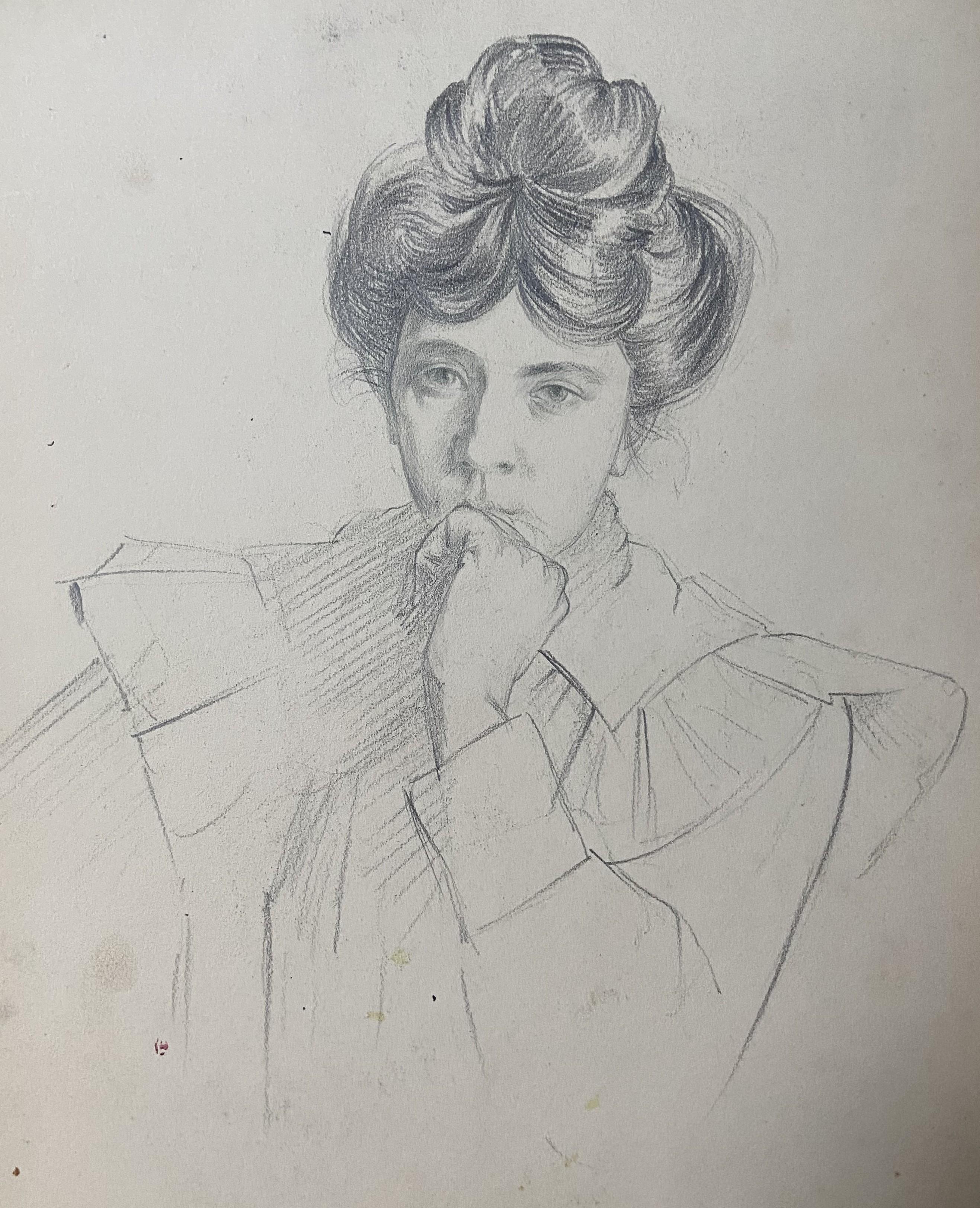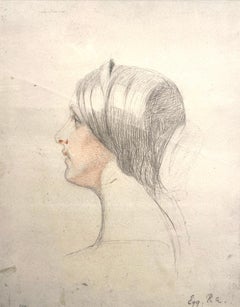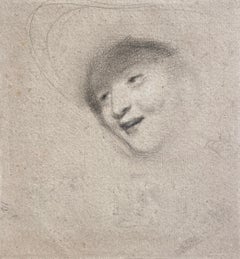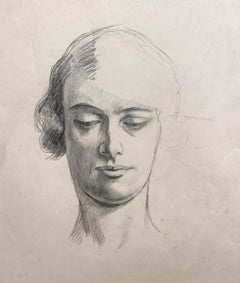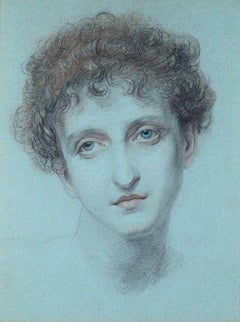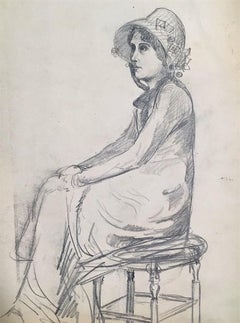Items Similar to Head of a Young Woman
Want more images or videos?
Request additional images or videos from the seller
1 of 3
Karl ParsonsHead of a Young Woman1907
1907
$9,106.90
£6,600
€7,757.69
CA$12,386.01
A$13,878.45
CHF 7,224.26
MX$169,781.55
NOK 91,698.66
SEK 86,608.29
DKK 57,912.76
Shipping
Retrieving quote...The 1stDibs Promise:
Authenticity Guarantee,
Money-Back Guarantee,
24-Hour Cancellation
About the Item
Karl Parsons
English 1884 - 1934
Head of a Young Woman
Graphite on paper
Signed and dated '(19)07' lower left
Image size: 6 1/4 x 8 1/2 inches (16 x 21.5 cm)
Contemporary Pre-Raphaelite style frame
One of Britain's leading stained glass designers during the early decades of the 20th century, Karl Parsons drew portraits invariably for pleasure rather than commissions, throughout his life, and it is in these that one sees most clearly the influence of some of the artists whom he most admired, notably Botticelli, Rossetti and Burne-Jones.
Though harkening back to these illustrious forebears, both technically and compositionally, this portrait also epitomises the type of portraiture that was fashionable in British high society at the start of the 20th century. Karl Parson's technique here, with delicate shading and strong outlines, is certainly comparable to Gerald Leslie Brockhurst's graphic style. It is clear that Parsons took delight in demonstrating his skill at sculpting human forms through gentle shading.
Karl Parsons was an English stained glass artist associated with the arts and craft movement. Parsons was born in Peckham in Surrey in 1884, the 12th child of Arthur William Parsons (1838–1901), a foreign language translator, and Emma Matilda Parsons, née Bergemann (1837–1914).One of Parsons’ older sisters was the artist Beatrice Emma Parsons (1869–1955).
Karl Parsons career was devoted to stained glass, becoming in 1899 a pupil-apprentice of Christopher Wall, the leading Arts and Crafts proponent of this medium. Parsons was a gifted student, from the outset collaborating on major commissions, such as that for the Gloucester Cathedral. By 1910, Parsons had set up his own studio, and would undertake several more significant commissions, including for the windows of Canterbury, Cape Town and Johannesburg cathedrals.
- Creator:Karl Parsons (1884 - 1934, English)
- Creation Year:1907
- Dimensions:Height: 6.25 in (15.88 cm)Width: 8.5 in (21.59 cm)
- More Editions & Sizes:6 1/4 x 8 1/2 inches Price: $9,107
- Medium:
- Movement & Style:
- Period:
- Condition:
- Gallery Location:London, GB
- Reference Number:1stDibs: LU52410483192
About the Seller
5.0
Vetted Professional Seller
Every seller passes strict standards for authenticity and reliability
Established in 2007
1stDibs seller since 2014
82 sales on 1stDibs
Typical response time: 3 hours
- ShippingRetrieving quote...Shipping from: London, United Kingdom
- Return Policy
Authenticity Guarantee
In the unlikely event there’s an issue with an item’s authenticity, contact us within 1 year for a full refund. DetailsMoney-Back Guarantee
If your item is not as described, is damaged in transit, or does not arrive, contact us within 7 days for a full refund. Details24-Hour Cancellation
You have a 24-hour grace period in which to reconsider your purchase, with no questions asked.Vetted Professional Sellers
Our world-class sellers must adhere to strict standards for service and quality, maintaining the integrity of our listings.Price-Match Guarantee
If you find that a seller listed the same item for a lower price elsewhere, we’ll match it.Trusted Global Delivery
Our best-in-class carrier network provides specialized shipping options worldwide, including custom delivery.More From This Seller
View AllPortrait Study of a Young Girl, Signed 19th Century Victorian Sketch
By Augustus Leopold Egg
Located in London, GB
Pencil and coloured chalk on paper, signed bottom right
Image size: 9 3/4 x 7 3/4 inches (3.75 x 3 cm)
Mounted and framed
Provenance
Studio sale, Christies 18th May 1863
The Artis...
Category
Mid-19th Century Portrait Drawings and Watercolors
Materials
Paper, Chalk, Pencil
Graphite Study of a Head, Monogrammed Victorian Sketch, Gilt Fame
By Henry Perronet Briggs
Located in London, GB
Graphite on paper, monogrammed lower left
Image size: 6 x 6 1/2 inches (15.25 x 16.5 cm)
Contemporary style handmade gilt frame
Henry Perronet Briggs
Henry Perronet Briggs RA wa...
Category
Early 19th Century Portrait Drawings and Watercolors
Materials
Paper, Graphite
Portrait of a Young Woman
By Sir Peter Lely
Located in London, GB
Red chalk on paper
Image size: 7 1/2 x 9 1/4 inches (19 x 23.5 cm)
Contemporary frame
An enigmatic portrait of a young woman after Sir Peter Lely's drawing, currently shown in the B...
Category
Mid-17th Century Victorian Portrait Drawings and Watercolors
Materials
Paper, Chalk
Study of a Woman, Graphite Sketch, 20th Century British Artist, Signed
Located in London, GB
Graphite on paper, signed on reverse
Image size: 11 x 9 1/2 inches (28 x 24 cm)
Mounted and framed
Ernest Proctor
Born in Tynemouth, Northumberland, the son of a scientist, Ernest was educated at Bootham Friends' School in York and then came to Newlyn in 1907 to study with Stanhope Forbes. He quickly become recognized as the best student of the School. He acted as Assistant to Stanhope Forbes and Elizabeth Forbes...
Category
20th Century Modern Portrait Drawings and Watercolors
Materials
Paper, Graphite
Portrait of Marguerite Folin, Gerald Brockhurst
By Gerald Leslie Brockhurst
Located in London, GB
Gerald Leslie Brockhurst
1890 – 1978
Portrait of Marguerite Folin
Oil on panel, signed lower right
Image size: 18 x 14 inches (45.7 x 34.3 cm)
Original frame
The sitter for this po...
Category
Early 20th Century Art Nouveau Portrait Paintings
Materials
Oil
Portrait of a Lady, 19th Century French School Chalk on Paper
Located in London, GB
French School
19th Century
Portrait of a Lady
Coloured chalks on paper
Image size: 10 x 7 inches
Contemporary gilt frame
Category
19th Century Portrait Drawings and Watercolors
Materials
Paper, Chalk
You May Also Like
Ellen, A Greek Model - PreRaphaelite chalk portrait drawing
Located in London, GB
FREDERIC JAMES SHIELDS, ARWS
(1833-1911)
Ellen, A Greek Model
Signed and indistinctly inscribed with the name of the sitter on the reverse
Chalks
37 by 28.5 cm., 14 ½ by 11 ¼ in.
(frame size 63.5 by 54.5 cm., 25 by 21 ½ in.)
Provenance:
The Artist’s estate;
Private collection.
Shields was born in Hartlepool and brought up in extreme poverty with most of his family succumbing to TB. Employed by a commercial engraver he studied at evening classes in London and then in Manchester, where he settled in 1848. He was greatly impressed by the works of the Pre-Raphaelite Brotherhood, which he saw at the Manchester Art Treasures Exhibition in 1857. The quality of his illustrations for Defoe’s History of the Plague (1862) and Bunyan’s Pilgrim’s Progress...
Category
Late 19th Century Pre-Raphaelite Portrait Drawings and Watercolors
Materials
Chalk
Portrait of a Young Woman - Pre-Raphaelite Victorian drawing girl white collar
Located in London, GB
This beautiful Victorian pencil drawing dates to around 1890 and is by an unknown hand. It is a head and shoulders portrait of a young lady gazing to her right. Her dark hair is tied...
Category
19th Century Pre-Raphaelite Portrait Paintings
Materials
Charcoal, Pencil
$3,973 Sale Price
20% Off
André Eugène Costilhes (1865-1940) Young woman in profile, drawing
By André Eugène Costilhes
Located in Paris, FR
André Eugène Costilhes (1865-1940)
Young woman in profile
bears the stamp of the studio of André Eugène Costilhes in the lower right-hand corner
pencil on paper
30.5 x 20 cm
In go...
Category
Early 1900s Symbolist Portrait Drawings and Watercolors
Materials
Pencil
Portrait of a Young Woman - 1900s - René François Xavier Prinet - Drawing
By René Francois Xavier Prinet
Located in Roma, IT
Portrait of A Young Woman is an original artwork realized by the French artist and illustrator René François Xavier Prinet between the end of the XIX and the beginning of the XX cent...
Category
Early 1900s Modern Figurative Drawings and Watercolors
Materials
Paper, Pencil
André Eugène Costilhes (1865-1940) Portrait of a lady, drawing
By André Eugène Costilhes
Located in Paris, FR
André Eugène Costilhes (1865-1940)
Portrait of a Lady
bears the stamp of the studio of André Eugène Costilhes in the lower right-hand corner
pencil red chalk and heightenings of whi...
Category
Early 1900s Symbolist Portrait Drawings and Watercolors
Materials
Pencil
André Eugène Costilhes (1865-1940) A Pensive young woman, portrait drawing
By André Eugène Costilhes
Located in Paris, FR
André Eugène Costilhes (1865-1940)
A Pensive young woman
pencil on paper
29.5 x 22.5 cm (view)
In good condition, except some traces of stains
Framed : 55.5 x 41.5 cm (vintage frame...
Category
1910s Symbolist Portrait Drawings and Watercolors
Materials
Pencil
More Ways To Browse
Head Human
Drew Young
Pre Raphaelite
Watercolor Painting Gloucester
Antique English Stained Glass
Botticelli Paintings
Arts And Crafts Stained Glass Window
Antique Technical Drawing Set
Old Antique Stained Glass Windows
Beatrice Parsons
Emma Jones
Gerald Nees
Fairmont Designs
Royal Christmas Card
Peter Coker
A Giannelli
Antique Sikh Art
George Stavrinos
